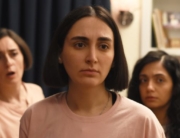![]() “Lizzie Borden took an axe/and gave her mother 40 whacks/When she saw what she had done/gave her father 41.” Film-Forward reprints this macabre nursery rhyme for readers who may not have grown up knowing the real-life story of the woman who infamously murdered her father and stepmother in Fall River, Massachusetts, in 1892. Chloë Sevigny has now produced and starred in a version of Lizzie Borden folklore that pumps an old legend with thrilling, haunting life. Part feminist revenge tale, part psychological family drama, and part unlikely love story that finally erupts in screaming murder, Lizzie daringly focuses disparate forces with an unswerving vision.
“Lizzie Borden took an axe/and gave her mother 40 whacks/When she saw what she had done/gave her father 41.” Film-Forward reprints this macabre nursery rhyme for readers who may not have grown up knowing the real-life story of the woman who infamously murdered her father and stepmother in Fall River, Massachusetts, in 1892. Chloë Sevigny has now produced and starred in a version of Lizzie Borden folklore that pumps an old legend with thrilling, haunting life. Part feminist revenge tale, part psychological family drama, and part unlikely love story that finally erupts in screaming murder, Lizzie daringly focuses disparate forces with an unswerving vision.
Although Lizzie lives in her rich father’s house with her sister and stepmother, she might as well be locked up in solitary confinement. The family’s cold, contemptuous patriarch (icy-voiced Jamey Sheridan) uses Lizzie’s epileptic seizures as a pretext to confine her at home. Her clumsy attempt to rebel brings on a gruesome act of retaliation by her father, all the more frightening in the film’s brisk delivery and matter-of-fact follow-up. Far from the cozy Victorian interiors of Masterpiece Theater, the bleak house bristles with menace; everyone here is listening at doors, peeping through windows, lying in wait.
Lizzie faces a stark future. Her father plans to make her sinister uncle (Denis O’Hare) his executor, disinherit her and her sister, and send Lizzie to an institution. The young woman’s isolation is breached by the arrival of a young Irish maid, Bridget (Kristen Stewart), referred to derisively and generically by the rest of the family as Maggie; in this household, women don’t even have the right to their own names. Lizzie befriends lonely Bridget and teaches her to read. But when the father begins to creep every night into Bridget’s bedroom, the two women join together out of desperation. First they’ll become lovers—which Lizzie handles with both hotness and hushed wonder—then move onto unspeakable deeds.
Director Craig William Macneill cannily (or uncannily) alternates a restrained sense of domestic suffocation with heightening panic, like a pillow over the face with the knife at the throat. Cinematographer Noah Greenberg uses natural light to frame deceptively simple shots that reveal the characters’ wary dynamics. Silhouettes, profiles, and arched backs signal tense alertness in constricted spaces. Dialogue feels stripped-down and real in contrast to the swooning, keening score.
Stewart uses her trademark recessiveness differently than usual, making it part of Bridget’s naivety. But it’s Sevigny’s instinctive turn that burns a hole in the Mylar. She heightens Lizzie to a totem of frustration and rash defiance, dead set on cutting the noose tightening around her neck. The explosively cathartic murder sequence toward the end fulfills a prophecy foretold, confirming with many a blow something we intuitively knew from the beginning—there’s no messing with this Lizzie Borden. They had it coming.







Leave A Comment